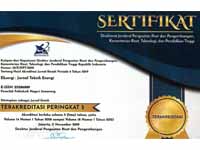Analysis of Solar Cell Utilization as an Automated Pump Driver in a Fishpond
DOI:
https://doi.org/10.32497/eksergi.v18i2.3583Keywords:
solar panels, Water Level Control, PumpsAbstract
The purpose of making this final task is to apply the solar power system as a source of electrical energy to move the water pump automatically in fish ponds. This system works automatically with the Water Level Control tool sensor (WLC), so that if the water level drops or rises then the water pump will automatically work. On this automated system use the Smart Relay SR2B121BD and the ZelioSoft 2 application. Data retrieval carried out at 10.00 -14.00 WIB, obtained data pumps 1 and 2 for a height of 1 cm for 30 minutes and a height of 2 cm for 70 minutes. The amount of discharge the pump produces 1 and 2 ranges from 37 L/M to 45 L/M. Pump 1 Test results obtained an average efficiency of 7.68%, with the highest efficiency of 11.03% and the lowest efficiency of 5.26%, while the average pump efficiency of 2, 7.05% with the highest efficiency of 10.66% and the lowest efficiency of 5.41%. The average efficiency of the solar panels is 11.20% with the highest efficiency of 14.60% and the lowest efficiency of 7.29%
References
Abdelkader, M. R. dkk.(2010). A
comparative Analysis of the Performance of
Monocrystalline and Multiycrystalline PV Cells iSemi
Arid Climate Conditions: the Case of Jordan
Erinofiardi,Imam Supardi dan Redi.(2012). Penggunaan PLCdalam
Temperatur Simulasi pada Prototype Ruangan
Iqtimal,Z., Sara,I.D., Syahrizal.(2018). Aplikasi Sistem Tenaga
Surya Sebagai Sumber Tenaga Listrik Pompa Air
Ishak,L.F., Sadi,S., Pribadi,D.,(2015). Sistem Kontrol
Temperatur Menggunakan Plc Zelio Sr2 B121 Bd,
Simulasi Pada Prototype Ruangan Dengan Suhu 29 °C
- 36 °C
Iswanto, Ady.(2008). Prinsip Dasar Solar Cell, Staf Divisi Riset
FM ITB, Bandung
Laksono, Teguh Pudar Mei.(2013). Sistem Scada
Water Level Control Menggunakan Software
Wonderwareintouch. Universitas Negeri Semarang
Parastiwi, Andriani dkk.(2018). Photovoltaic Terapan
:Teknologi dan Implementasi. Malang : Polinema Express
Rosyadi, Nasrul Haq.(2016). AnialisisPotensi Pembangkit
Listrik Tenaga Hibrida Energi Angin dan Energi Surya Dalam
Penyediaan Energi Listrik Di Desa Banaran, Yogyakarta. Universitas
Muhammadiyah Yogyakarta
Suarda, Made., Wirawan, I Ketut Gede.(2009).
Kajian Teknis Dan Ekonomis Pembangkit Listrik
Tenaga Surya Di Desa Sanapahaan Kecamatan
Kediri. Universitas Udayana
Sularso,Tahara,H,. 2003. Pompa danKompresor.Jakarta
Tjok Gde. Visnu Semara Putra.(2015). Analisa Unjuk
Kerja Pembangkit Listrik Tenaga Surya 15 KW Di Dusun
Asah Teben Desa Datah Karangasem. Bali:
UniversitasUdayana.
Utari, Evrita Lusiana.(2017). PerancanganAlat Inducsion Heating
pada Pengolahan Teh Sangrai dengan Teknologi
Energi Terbarukan (Solar Cell)
Wijaya,I.W.A,Partha,C.G.I.(2013). Pemanfaatan Energi Matahari
untuk Penggerak Pompa Air Listrik Arus DC
Kurnianto, D., Hadi, A. M., & Wahyudi, E. (2016). Perancangan
Sistem Kendali Otomatis pada Smart Home menggunakan Modul
Arduino Uno. Jurnal Nasional Teknik Elektro, 5(2).
https://doi.org/10.20449/jnte.v5i2.276Kusuma, N. A. A., Yuniarti, E.,
& Aziz, A. (2018).
Rancang Bangun Smarthome Menggunakan Wemos D1 R2 Arduino
Compatible Berbasis ESP8266 ESP-12F. Al-Fiziya: Journal of
Materials Science, Geophysics, Instrumentation and Theoretical
Physics, 1(1). https://doi.org/10.15408/fiziya.v1i1.8992
Ade Septryanti, & Fitriyanti. (2017). Berbasis Mikrokontroler Arduino
Menggunakan. Rancang Bangun Aplikasi Kunci Pintu Otomatis
Berbasis Mikrokontrol Arduino Menggunakan Smartphone Android,
(2), 59”“63.
Juwariyah, “Perancangan Sistem Deteksi Dini Pencegah Kebakaran
Rumah Berbasis ESP8266 dan Blynk”, Juni 2018.
Downloads
Published
Issue
Section
License
Authors who publish with this journal agree to the following terms:Authors retain copyright and grant the journal right of first publication with the work simultaneously licensed under a Creative Commons Attribution License that allows others to share the work with an acknowledgement of the work's authorship and initial publication in this journal.
Authors are able to enter into separate, additional contractual arrangements for the non-exclusive distribution of the journal's published version of the work (e.g., post it to an institutional repository or publish it in a book), with an acknowledgement of its initial publication in this journal.
Authors are permitted and encouraged to post their work online (e.g., in institutional repositories or on their website) prior to and during the submission process, as it can lead to productive exchanges, as well as earlier and greater citation of published work (See The Effect of Open Access).






